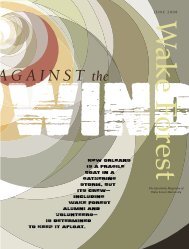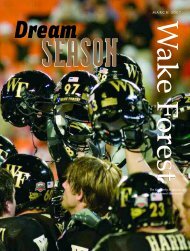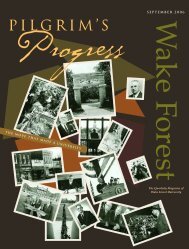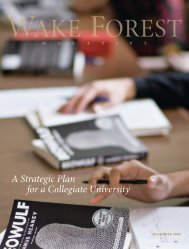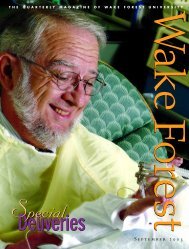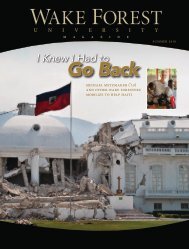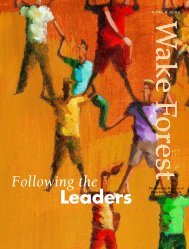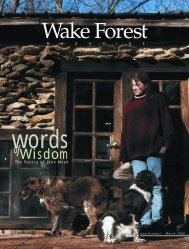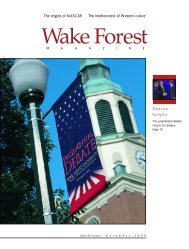Wake Forest Magazine, December 2004 - Past Issues - Wake Forest ...
Wake Forest Magazine, December 2004 - Past Issues - Wake Forest ...
Wake Forest Magazine, December 2004 - Past Issues - Wake Forest ...
You also want an ePaper? Increase the reach of your titles
YUMPU automatically turns print PDFs into web optimized ePapers that Google loves.
the most powerful and dominant to<br />
have ever competed in the ACC.<br />
A tradition has to have great<br />
players, national championships, and<br />
more importantly, a long stretch of<br />
dominance that is unmatched. The<br />
Deacons had it all during Haddock’s<br />
tenure, and it’s something that his<br />
numerous former players say was something<br />
to behold. There were three<br />
national championships (1974, ’75,<br />
and ’86) and countless All-Americas<br />
who went on to have, or are still having,<br />
outstanding careers in the pros.<br />
And there were several All-Americas<br />
and key players who didn’t play golf<br />
professionally but were just as important<br />
to Haddock’s motto of team play.<br />
How did such a small school build<br />
such a deep tradition that some say<br />
has carried through even some of the<br />
lean times? One reason it has probably<br />
been such a success was that it<br />
never got lost in other sports, the way<br />
golf can sometimes get lost at much<br />
bigger schools.<br />
And then there’s the family atmosphere<br />
that surrounds the program.<br />
“Everybody looks out for one another,”<br />
said Jay Sigel (’67), who wound up<br />
being the first recipient of the Arnold<br />
Palmer scholarship and was on one<br />
of Haddock’s first great teams. “Everybody<br />
cares for the other guy and we<br />
all come back often and I’m amazed<br />
at how well the school does with<br />
academics, socially, athletically, and<br />
everything else,” he said.<br />
There are names such as Palmer,<br />
Sigel, Lanny Wadkins (’72), Curtis<br />
Strange (’77), Jay Haas (’76), Scott<br />
Hoch (’78), Billy Andrade (’87), Len<br />
Mattiace (’90), Joe Inman (’69), and<br />
Thompson (’70), and most recently,<br />
Jay’s son, Bill (’04), who are probably<br />
the most well-known of the former<br />
Deacons. But the list of other great<br />
players could go on and on, such as<br />
18 WAKE FOREST MAGAZINE<br />
Jack Lewis (’70), Ken Folkes (’64),<br />
Gary Hallberg (’80), Chris Kite (’88),<br />
Tim Straub (’89), Eddie Pearce (’74),<br />
Jim Simons (’72), Billy Joe Patton (’43),<br />
Jerry Haas (’85), Ronny Thomas (’60),<br />
Robert Wrenn (’81), Bob Byman (’77),<br />
David Thore (’78), and countless others.<br />
An incredible fifty-eight players<br />
since 1964 were named on one of<br />
the three All-America teams or honorable<br />
mention, including Hallberg,<br />
who was first team All-America four<br />
straight years. Hallberg (1979),<br />
Strange (1974), and Jay Haas (1975)<br />
also won the individual NCAA title.<br />
Bill Haas won a school-record ten<br />
tournaments and set numerous other<br />
records along the way, and he will<br />
likely become the next former Deacon<br />
to star on the PGA Tour.<br />
“The tradition means a lot to me,”<br />
Bill Haas said upon his graduation<br />
last May. “There have been so many<br />
times people ask me where I go to<br />
school and when I say <strong>Wake</strong> <strong>Forest</strong><br />
they say ‘That’s a great golf school.’<br />
And then when I say ‘I play golf for<br />
them’ they automatically think you<br />
are a great golfer.”<br />
Two years ago the ACC came out<br />
with its fifty greatest athletes in each<br />
sport, and several former <strong>Wake</strong> <strong>Forest</strong><br />
golfing greats were left off that list.<br />
That’s a testament to how dominant<br />
the program has been. It would be hard<br />
enough to name the top fifty golfers<br />
of all time at <strong>Wake</strong> <strong>Forest</strong>. When you<br />
consider the Deacons’ first real great<br />
stretch of talented teams took place<br />
from 1962 to ’72—when they finished<br />
in the Top 10 in the NCAA Championship<br />
nine times—that’s when the tradition<br />
started rolling.<br />
“I was very fortunate and people<br />
believed in me,” said Haddock, who<br />
is now 77. “But I never thought of<br />
myself as the main reason we won a<br />
lot. I was probably more self-con-<br />
scious of other things in the way the<br />
golf program evolved and the way the<br />
players looked at me.”<br />
Haddock retired in 1992 with his<br />
legacy cemented as one of the best<br />
college golf coaches of all time. He<br />
acknowledges he didn’t know much<br />
about the swing, but when it came to<br />
knowing what made his players tick,<br />
he was a guru.<br />
He helped guide the Deacons to<br />
fifteen of the school’s eighteen ACC<br />
titles, the most by any ACC school,<br />
despite not having won one since<br />
1989. “When you look back at where<br />
the tradition started, the first star and<br />
all of that, it had to be Arnold,” said<br />
Strange, who was part of what many<br />
consider the greatest college golf team<br />
of all time in 1975. “Yes, Arnold was<br />
our first star and our brightest star,<br />
but the way I look at it, that tradition<br />
doesn’t start overnight. And it doesn’t<br />
start with one player, but an entire<br />
program with many people. And I<br />
think that’s where Coach Haddock<br />
comes into it because he did more<br />
than anybody.”<br />
Strange said that Haddock’s genius<br />
was that he got in a player’s head, and<br />
it usually worked. “Everybody was<br />
different, but he had a way of bringing<br />
out your best,” Strange said. “We<br />
kidded a lot with Coach and with<br />
some of his methods, but he was<br />
good for me. I can only speak for<br />
myself, but he was perfect for me. We<br />
all need a little discipline at that age,<br />
and he knew how to get you going.”<br />
Just how deep were the Deacons<br />
back in the mid-’70s? Haddock said<br />
that at one point his B team went to a<br />
tournament and wound up winning<br />
by 20 shots. The next year, that tournament<br />
politely asked Haddock if he<br />
could bring just one team. There was<br />
probably not a better stretch of dominance<br />
in the program than at one




